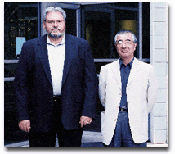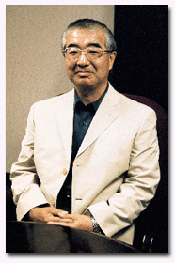Supply SideBy McAllister Isaacs III, Editorial Director At 30, Tekmatex Readies For Industy ReboundFlowing with the highs and lows of U.S. textiles, Charlotte-based Tekmatex anticipates ‘return of textiles.’ At Tekmatex, there may be a lull in business right now, as the Charlotte-based distribution firm quietly reaches its 30th birthday. But it isnt just sitting around waiting for something to happen. No, the company is gearing up for what Yuji Wada, president, describes as “a return of textiles to the United States.”

Left to Right: Danny Barrett, general manager, Weaving Division, and Yuji Wada, presidentWada says, “I firmly believe that the textile industry will return in the United States, perhaps with a different structure. But it will come back in the future after structures of apparel, textile industries and textile retailers are reorganized and connected under common value chains with QR systems thus eliminating inventories just as the relationship between automobile assembly makers, parts and components makers.”Tekmatex, located in the heart of the U.S. textile industry in Charlotte, has witnessed a number of peaks and valleys in this industry in its 30-year history.The company opened its doors in 1971 in downtown Charlotte while it awaited the completion of its building, at its current site on Performance Road. Ironically, with American Dornier a nearby neighbor, back then Performance Road was known as Picanol Road. Needless to say, at least two of the current residents on the street pushed for a renamingand got it. Thus, it is now Performance Road.In 1971, Tekmatex began its U.S. history as the sales representative for Nissan water-jet weaving machines and Toyoda open-end spinning machines. Nissan opened its own U.S. office in 1977 (recently purchased by Toyota). Today, of course, Tekmatex handles U.S. sales for Tsudakoma weaving machines, preparatory machines and Toyota spinning systems.Danny Barrett, general manager, Weaving Div., supervises the sales and service of the Tsudakoma weaving machines and preparatory machines. Barrett said day to day contact with textile companies by the companys two regional sales managersLuther Lingle covering part of the Carolinas and all points north and Gary Hinkle covering part of the Carolinas and all points south have advanced Tsudakoma machinery sales to over 12,000 machines. Furthermore, Barrett said close contact with current customers by Tekmatex technical service managersSonny Burr and Alan Reeves has ensured our customers learn of new developments to remain competitive.Ron Wilson, sales manager, Spinning Div., as well as the Woodworking Div., joined Tekmatex 12 years ago and supervises the sales and services of the Toyota yarn-making products.Barrett, a 20-yr veteran at Tekmatex has certainly been witness to the evolution of air-jet weaving from a machine with a highly limited applications capability in its early days to one that has captured the hearts and minds of most weaversespecially in the U.S. With over 12,000 air-jet weaving machines in the U.S., Barrett is certainly well qualified to discuss that evolution.”In the early days,” he says, “most air jets produced plain weave fabricsfrom common yarns, making common products. A lot of folks were making shirtingsoxfords, broadcloths. Machines were all 190-cm wide, except, of course, the 150- to 170-cm machines for glass fiber fabrics. In the beginning, it was all crank shedding.”Over the years, several things happened to change all that:1) Machines became wider.2) Machines were beefed up to produce different and more difficult fabrics.3) Filling insertion evolved to include multiple feeders and capabilities for diverse yarns.Sheeting provides an excellent example of the use of wider air jets. Denim is an application where beefing up the machine generated new use. In fact, where denim was once the sole province of projectile machines, hardly a yard is woven today on anything other than an air-jet machineat least in the U.S. And, of course, its not uncommon to find eight filling feeders with dobby or jacquard shedding on todays air jets.Barrett says, “Tsudakoma has more machines on sheeting than any other manufacturer.”Moreover, in a fabric few ever thought possible, Tsudakoma has more air jets on terry than any other manufacturer, according to Barrett. The company is also producing 230-cm water jets, the widest on the market for the growing automotive airbag market.As for Tekmatex itself, it is owned neither by Tsudakoma or Toyota. Marubeni America corp. owns 80% of the Charlotte-based facility. The Marubeni Group in Japan owns the other 20%. Moreover, The Marubeni Group owns Marubeni America Corp.Wada says the Marubeni Group is one of the largest trading companies in the world. It deals in 30,000 different items such as steel, automobiles, ships, plant construction, power stations, housing, IT, logistics, finance, petroleum, energy, chemicals, food, textiles and machinery, including textile machinery. It has facilities in 150 countries and districts all over the world.In the U.S. the company has the Tekmatex Inc. operation in Charlotte and Swift Spinning Mills and Marubeni Denim in Columbus, Ga, and Wateree Textile in Camden, S.C., in the textile field.

President Yuji Wada firmly believes that “Textiles will return to the United States, perhaps with a different structure.”Wada, himself, has served the parent company with two different stints at the Charlotte operation. He first worked at Tekmatex Inc. from 1976 to 1983. He returned in 1998 as president and has been at the helm ever since. Tekmatex Inc. actually has five divisions. The table shows these divisions with their current and new products. Each division has sales personnel, service technicians and a full complement of spare parts to service each division and more importantly our customers. The bottom line on Tekmatex is over the last 30 years, the company has been through the up and down cycles side by side with its partners in the textile community and plans to remain a leader in the sales and service of its products.October 2001




